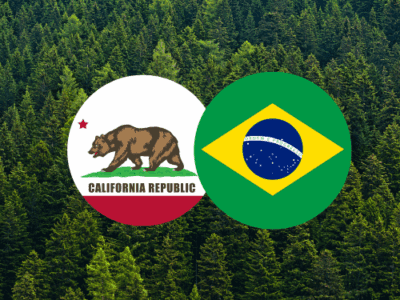From the Wildfire Files
Wildfires are getting worse and worse. Here’s what we know about the situation.
I don’t normally do this, but given the terrible wildfires now hitting the state, I thought it was worth doing a reprise of some posts on the subject from earlier this summer. Of course, there’s more information in the original posts, if you want to click over to them.
Spreading Like Wildfire
In 2017, wildfires burned 10 million acres in the Western United States, destroying 12,000 homes, killing 66, and resulting in $18 billion in damages. Last year, fires swept through California’s wine country. Fire in Sonoma county killed 23 people, burned 36,000 acres and destroyed more than 5000 homes. The total estimated damage was over $1 billion, according to the state insurance commissioner. And now the current fires!
What’s happening in California isn’t an isolated phenomenon.
“There’s been a notable increase in the large wildfires — defined as those 1,000 acres or bigger. A Climate Central analysis of U.S. Forest Service data through 2014 shows that large fires are three-and-a-half times more common now than they were in the ‘70s. “ They also burn seven times more acreage in an average year. “The biggest changes are in the Northern Rockies. Large wildfires are now 10 times more common than they used to be and the area burned is up to 45 times greater in Idaho, Montana and Wyoming.”
Earlier, Union of Concerned Scientists observed that “between 1986 and 2003, wildfires occurred nearly four times as often, burned more than six times the land area, and lasted almost five times as long when compared to the period between 1970 and 1986.” So, what’s causing the fires? That was discussed in the next post.
Burning in the Heat
The U.S. government’s 2017 Climate Assessment concluded that “[r]ecent decades have seen a profound increase in forest fire activity over the Western United States and Alaska.”
Causation is a complicated issue in the context of wildfires. As the 2017 Assessment explains, “the frequency of large wildfires is influenced by a complex combination of natural and human factors,” including “[t]emperature, soil moisture, relative humidity, wind speed, and vegetation (fuel density).” Despite the complications, there are strong reasons to link wildfires and climate change. For instance, a 2016 study of fires in the Western United States concluded that climate change more than doubled the area burned by forests fires from 1984 to 2005. The result: an additional 16,000 square miles destroyed. The 2017 Assessment – keep in mind that this was issued by the government during the Trump Administration – says that fires used to be rare in Alaska, but “historically less flammable tundra and cooler boreal forest regions could shift into historically unprecedented fire risk regimes” due to rising temperatures.
Because fire causation and spread are complex, it’s hard to be confident about just how much impact climate change will have in coming decades, at least outside of Alaska where the predictions are strongest. But there’s every reason to expect more large fires in our future. The final post discusses how we can manage this increased risk – beyond getting smarter about reducing carbon emissions, of course.
Managing the Risks
Land Use Controls.
There are increasing numbers of people moving into the wild-land urban interface (WUI).The USDA’s report on the WUI says that 3.8 million people live in that zone in California alone. Nationally, a million homes were added to the WUI just in the decade from 1990-2000. That simply isn’t sustainable.
Land Management.
Vegetation removal, both in forests and in the WUI, can reduce the likelihood of fires and slow their spread. The trouble is that this gets harder all the time. In California, the fire zone has doubled, now including nearly half of the state, and there are said to be nine million acres where the risk is intensified by dead trees due to drought or bark beetles. Obviously, a much greater effort is going to be needed, and care has to be taken to minimize the environmental impacts of the vegetation removal.
Utility Precautions.
Wildfires can be started by downed power lines, a cause of the 2017 California Wine Country fires. Utilities have automatic shut-offs when lines go down, but they also have automatic reclosers to restart them. Those reclosers should be shut off during fire season. But experts say the failure to do so or provide for human oversight has contributed to major fires in California and elsewhere. Undergrounding wires or replacing wooden poles with steel ones, which some utilities have done in fire prone areas, also help. According to Utility Dive, San Diego Gas & Electric has been a leader on wildfire prevention.
Emergency Response.
The Sonoma County fire of 2017, which killed forty-four and destroyed almost nine thousand buildings, revealed serious flaws in fire response. As the San Jose Mercury News reports, the state’s Office of Emergency Services, which investigated the response, was sharply critical of local efforts: Earlier In the 2018 fire season, other problems surfaced. The SF Chronicle reported that in the last week of July alone, requests for 900 engines were unfilled in a breakdown of the mutual-aid system between localities. Although the mutual-aid system is well regarded by experts, there are limits to its capacity. The system needs more funding.
* * *
The fact is that wildfires are part of the “new normal.” We’re going to have to up our game to deal with this much higher level of risk. The strategies discussed here are the starting points.
Reader Comments
5 Replies to “From the Wildfire Files”
Comments are closed.







Excellent summary Prof. Farber.
We have most obviously received far too many warnings, over far too many years that politicians have failed to heed and act upon. Now we must continue to experience out of control destruction and human suffering until politicians, in both political parties, learn to act responsibly to protect us from continuing to suffer the most unacceptable consequences of past failures to accept the realities of global warming that Legal Planet scholars and the academic community have been trying to inform, educate and motivate them to act upon.
It appears that one immediate, paramount requirement is that our politicians must receive courses in global warming and how to act responsibly to protect We The People instead of focusing on the power of money that causes them to ignore public safety.
Please do your best to make the things happen with the greatest sense of urgency.
Are we to believe that California can effectively fight forest fires by mitigating climate change? Should we buy carbon credits or thin underbrush? Vehicle GHG emission standards and high speed rail may qualify as forest management for climate mongrels in California.
Dear Anthony, there is nothing Dan can do to make things happen, he cannot change the climate back to where it used to be when we were kids. We are old and getting closer to death everyday, why should we waste our precious time worrying about the climate of all things.
Many climate mongrels reject God hope to go black and cease to exist upon death, then all their troubles will be over and including climate. After going black one will never know the difference. If Hitler went black then he never had to worry about all the people he killed. Same with climate change, why worry about what may happen after one is dead? Many atheistic/agnostics place great Faith in going black. Climate doesn’t matter at all to those who are dead.
Anthony, Dan and I will all die before anyone changes the climate back to where it was before global warming. Why should anyone moan and groan about something mundane and immutable like climate, especially when we only have a short time left and other things are far more important?
There is nothing that anyone can do about climate change so it’s not worth worrying about not even for one minute. Climate seems like a silly game for fools who hope to go black. Who cares, don’t waste our time with your nonsense.
BQRQ, wildfires are most obviously a complicated problem to deal with.
An October IPCC news release defines the fact of life that global warming solutions will be extremely difficult to implement over the next 20 years:
http://www.ipcc.ch/pdf/session48/pr_181008_P48_spm_en.pdf
And Governor Brown just signed legislation to strengthen wildfire prevention in September:
https://www.gov.ca.gov/2018/09/21/governor-brown-signs-legislation-to-strengthen-wildfire-prevention-and-recovery/
So we must produce successful ways to inform, educate and motivate the public immediately if we are ever going to have any chance at all to prevent destruction of an acceptable quality of life for future generations.
BQRQ, wildfires are most obviously a complicated problem to deal with.
An October IPCC news release defines the fact of life that global warming solutions will be extremely difficult to implement over the next 20 years:
IPCC PRESS RELEASE Summary for Policymakers of IPCC …
https://www.ipcc.ch/pdf/session48/pr_181008_P48_spm_en.pdf
And Governor Brown just signed legislation to strengthen wildfire prevention in September:
Governor Brown Signs Legislation to Strengthen Wildfire …
https://www.gov.ca.gov/2018/09/21/governor-brown-signs-legislation…
So we must produce successful ways to inform, educate and motivate the public with the greatest sense of urgency if we are ever going to have any chance at all to prevent destruction of an acceptable quality of life for future generations.
BQRQ, wildfires are most obviously a complicated problem to deal with.
An October IPCC news release defines the fact of life that global warming solutions will be extremely difficult to implement over the next 20 years:
Summary for Policymakers of IPCC Special Report on Global Warming of 1.5ºC approved by governments
http://www.ipcc.ch/pdf/session48/pr_181008_P48_spm_en.pdf
And Governor Brown just signed legislation to strengthen wildfire prevention in September:
Governor Brown Signs Legislation to Strengthen Wildfire Prevention and Recovery
https://www.gov.ca.gov/2018/09/21/governor-brown-signs-legislation-to-strengthen-wildfire-prevention-and-recovery/
So we must produce successful ways to inform, educate and motivate the public immediately if we are ever going to have any chance at all to prevent destruction of an acceptable quality of life for future generations.